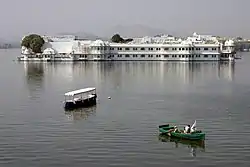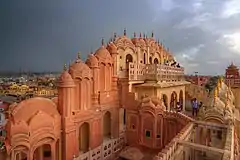
Rajasthan is one of the most popular tourist destinations in India, for both domestic and international tourists. Rajasthan attracts tourists for its historical forts, palaces, art and culture with its slogan "Padharo Mhare Desh (Welcome to my land.)"[1] The capital city, Jaipur, also known as Pink City, is a very popular tourist destination and is a part of the Golden Triangle. The Walled City of Jaipur is only the second Indian city to be recognized as a UNESCO World Heritage Site,[2] after Ahmedabad.
The palaces of Jaipur, lakes of Udaipur, and desert forts of Jodhpur, Bikaner, and Jaisalmer are among the most preferred destinations of many tourists, Indian and foreign. Tourism accounts for almost 15% of the state's domestic product.[3] In 2019, 52 million domestic tourists visited Rajasthan.[4]
Palaces
Rajasthan is known for its historical hill forts & palaces, it is claimed as the best place for tourism-related to palaces.
- Umaid Bhawan Palace: It is the largest Royal Palace in Rajasthan. It is also one of the largest private residences in the world.
- Lake Palace: It is now a luxury hotel located in Pichola Lake, Udaipur.
- Hawa Mahal: It is known as "Palace of Wind" or "Palace of Breeze" because there are more than 953 Windows in the Palace.
- Rambagh Palace: Formerly a Royal Palace now converted into a Heritage Hotel.
- Devi Garh Palace: Formerly a palace now converted into a Heritage Hotel, In 2006, The New York Times named it as one if leading luxurious hotel in Indian subcontinent.
Forts
Rajasthan is known for its forts. Hill Forts of Palaces in Rajasthan are also a part of world heritage.[5]
Hill forts in the World Heritage list
The six Hill Forts of Rajasthan, spread across Rajasthan state in northern India, clustered together as a designated UNESCO World Heritage Site. The forts are mainly based in the Aravalli Range,[6] and were built and enhanced between the 5th and 18th centuries CE by several Rajput kings of different kingdoms. They comprise:
- Chittor Fort at Chittorgarh
- Kumbhalgarh Fort at Kumbhalgarh
- Ranthambore Fort at Sawai Madhopur
- Gagron Fort at Jhalawar
- Amer Fort at Jaipur
- Jaisalmer Fort at Jaisalmer
- Khejarla Fort at Khejarla, Jodhpur
Some of these forts have defensive fortification wall up to 20 km long, still surviving urban centers and still in use water harvesting mechanism.[7]
Other forts
These are some of the prominent forts of rajasthan:
- Mehrangarh Fort
- Nahargarh Fort
- Bhatner fort
- Junagarh Fort
- Lohagarh Fort
- Gagron Fort
- Sirohi Fort
- Bhainsrorgarh Fort
- Taragarh Fort
- Jalore Fort
- Alwar Fort
- Achalgarh Fort
- Nagaur Fort
- Shergrah Fort
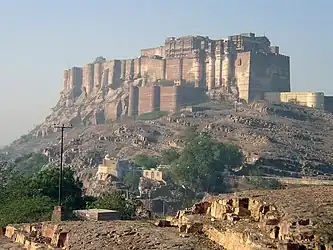

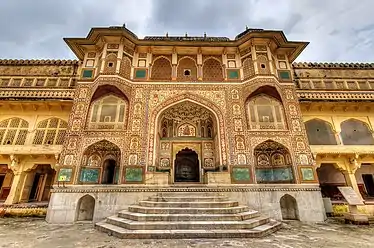 Ganesh Pol Entrance, Amer Fort
Ganesh Pol Entrance, Amer Fort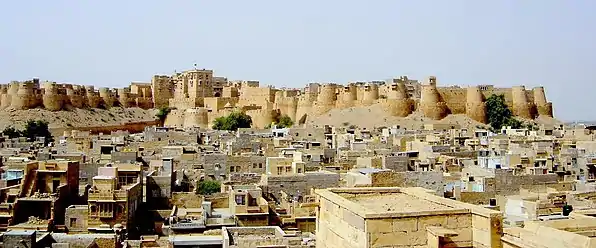
 Jain Temple inside Jaisalmer Fort
Jain Temple inside Jaisalmer Fort
 Carving of Kirti Stambh, Chittor Fort
Carving of Kirti Stambh, Chittor Fort
Fairs and Festivals
Department of Tourism of Rajasthan Government organizes multiple fairs & festivals during the year. These festivals & fairs are great tourist attractions. Fairs organized in Rajasthan include:
- Camel Festival, Bikaner (January)
- Nagaur Fair, Nagaur (Jan-Feb.)
- Kite Festival (held on 14 January of every year)
- Desert Festival, Jaisalmer (Jan-Feb.)
- Baneshwar Fair, Baneshwar (Jan-Feb.)
- Gangaur Festival, Jaipur (March–April)
- Mewar Festival, Udaipur (March–April)
- Elephant Festival, Jaipur (March–April)
- Urs Ajmer Sharif, Ajmer (According to Lunar Calendar)
- Summer Festival, Mt. Abu (June)
- Teej Festival, Jaipur
- Kajli Teej, Bundi (July–August)
- Dussehra Festival, Kota (October)
- Marwar Festival, Jodhpur (October)
- Pushkar Fair, Ajmer (November)
Wildlife Sanctuaries and National Parks
Rajasthan has many wildlife and bird sanctuaries. Prominent among them are Keoladeo Ghana Bird Sanctuary, Ranthambore National Park, Mukundara Hills National Park, Sariska Tiger Reserve and Desert National Park.
Religious Sites
Rajasthan has many famous temples from medieval times. Some prominent temples include Ghushmeshwar Temple, Eklingji Temple, Shrinathji Temple, Trinetra Ganesh Temple, Ranthambore, Mehandipur Balaji, Govind Dev Ji, Salasar Balaji, Ranakpur Jain temple, Osian temple, Brahma Temple, Pushkar and Dilwara Temples. Along with temples, there are a few important Sufi shrine too, most famous among them is Dargah (Tomb) of Khwaja Moinuddin Chishti.
Popular tourist attractions
- Ajmer - Popular for Ajmer Sharif Dargah and Soniji Ki Nasiyan Jain Temple.
- Barmer - Barmer and surrounding areas offer a perfect picture of typical Rajasthani villages.
- Bhilwara - Popular for its textile industry. Hamirgarh Eco-park and Harni Mahadev temple are important tourist destinations.
- Bikaner - Famous for its havelis, palaces and the Karni Mata Temple in Deshnoke.
- Chittorgarh - Popular for its monument and fort.
- Bundi - Popular for its forts, palaces and stepwell reservoirs known as baoris.
- Dausa - It is popular for Chand Baori and Mehandipur Balaji Temple.
- Jaipur - Known as pink city of India and the capital of Rajasthan.
- Jaisalmer - Famous for its golden fortress, havelis and some of the oldest Jain temples and libraries.
- Jhalawar district - Caves like Binnayaga Buddhist Caves, Hathiagor Buddhist Caves, Kolvi Caves are popular medieval architecture of India.
- Jodhpur - Famous for architecture, blue homes giving the name "Blue City" and Mehrangarh fort.
- Kota - Known for its gardens, palaces, and Chambal river safari.
- Mount Abu - A hill station with 11th century Dilwara Jain Temples. The highest peak in the Aravalli Range of Rajasthan, Guru Shikhar is just 15 km from the main town.mount abu is also good attraction for adventure lover . There are many kinds of adventure activities like trekking, caving,Rock climbing , Rappelling etc
- Nathdwara - This town near Udaipur hosts the temple of Shrinathji.
- Neemrana - home to the Neemrana Fort.
- Pushkar - It has the first and one of the very few Brahma temples in the world, and also his wife Savitri Devi's temple, built on a hilltop. The pushkar lake is considered sacred for Hindus.
- Ranakpur - Large Jain Temple complex with near 1444 pillars and exquisite marble carvings.
- Ranthambore - Situated near Sawai Madhopur. This town has historic Ranthambore Fort and one of the largest national park of India (Ranthambore National Park).
- Sariska Tiger Reserve - Situated in the Alwar district.
- Shekhawati - Located are small towns such as Mandawa and Ramgarh with frescoed havelis between 100 years to 300 years old, and Vedic period Dhosi Hill.
- Udaipur - Known as the "Venice of India".
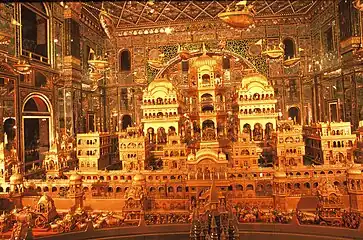

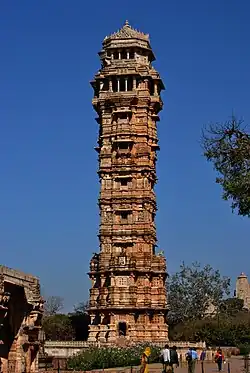
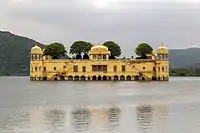
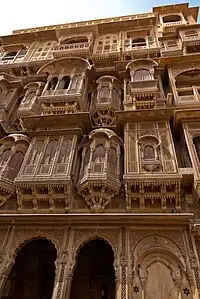
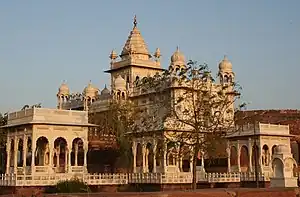
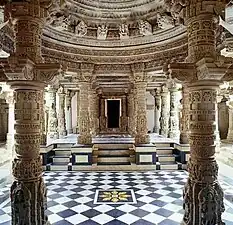 Dilwara Temples, near Mount Abu
Dilwara Temples, near Mount Abu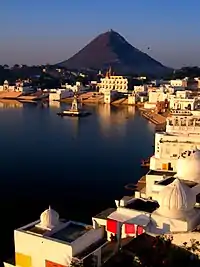 Ghats at Pushkar lake, Pushkar
Ghats at Pushkar lake, Pushkar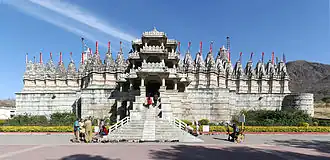
 Tiger in Ranthambore National Park
Tiger in Ranthambore National Park.jpg.webp) Shahpura Haveli, Shekhawati
Shahpura Haveli, Shekhawati
Outline of tourism in India
- List of World Heritage Sites in India
- List of national parks of India
- List of lakes of India
- List of waterfalls in India
- List of State Protected Monuments in India
- List of beaches in India
- Incredible India
- List of Geographical Indications in India
- Medical tourism in India
- List of botanical gardens in India
- List of hill stations in India
- List of gates in India
- List of zoos in India
- List of protected areas of India
- List of aquaria in India
- List of forts in India
- List of forests in India
- Buddhist pilgrimage sites in India
- Hindu pilgrimage sites in India
- List of mosques in India
- List of rock-cut temples in India
- Wildlife sanctuaries of India
- List of rivers of India
- List of mountains in India
- List of ecoregions in India
- Coral reefs in India
- List of stadiums in India
- List of museums in India
See also
References
- ↑ "'Padharo Mhare Desh': Rajasthan govt reverts to old tourism slogan". Hindustan Times. 30 January 2019. Retrieved 6 February 2023.
- ↑ Centre, UNESCO World Heritage. "Jaipur City, Rajasthan". UNESCO World Heritage Centre. Retrieved 6 February 2023.
- ↑ "Rajasthan Economy". business.mapsofindia.com. Retrieved 6 February 2023.
- ↑ "Tourism Department Annual Progress Reports - Rajasthan Tourism". www.tourism.rajasthan.gov.in. Retrieved 6 February 2023.
- ↑ "Hill Forts of Rajastan and Wooden Churches of the Carpathian region inscribed on World Heritage List". UNESCO World Heritage Centre. Retrieved 20 November 2016.
- ↑ Kohli, M.S. (2004), Mountains of India: Tourism, Adventure, Pilgrimage, Indus Publishing, pp. 29–, ISBN 978-81-7387-135-1
- ↑ UNESCO Hill Forts of Rajasthan, UNESCO website
